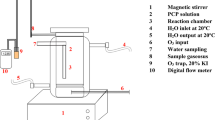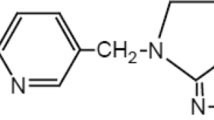Abstract
For aromatic monomer compounds (AMCs), ozonation outcomes were usually predicted by the substituents of the benzene ring based on the electron inductive effect. However, the predicted results were occasionally unreliable for complex substituents, and other factors caused concern. In this study, p-chloronitrobenzene (p-CNB) and ibuprofen (IBP) were selected for ozonation. According to the electron inductive theory, p-CNB should be less oxidizable, but the opposite was true. The higher rates of p-CNB were due to various sources of assistance. First, the hydroxyl radical (•OH) contributed 90 % to p-CNB removal at pH 7.0, while its contribution to IBP removal was 50 %. Other contributions came from molecular O3 oxidation. Second, p-CNB achieved 40 % of the total organic carbon (TOC) removal and fewer by-product types and quantities, when compared to the results for IBP. Third, the oxidation of p-CNB started with hydroxyl substitution reactions on the benzene ring; then, the ring opened. However, IBP was initially oxidized mainly on the butane branched chain, with a chain-shortening process occurring before the ring opened. Finally, the degradation pathway of p-CNB was single and consumed fewer oxidants. However, both branches of IBP were attacked simultaneously, and three degradation pathways that relied on more oxidants were proposed. All of these factors were determinants of the rapid removal of p-CNB.

Similar content being viewed by others
References
Bader H, Hoigné J (1981). Determination of ozone in water by the indigo method. Water Research, 15(4): 449–456
Baran W, Adamek E, Ziemiańska J, Sobczak A (2011). Effects of the presence of sulfonamides in the environment and their influence on human health. Journal of Hazardous Materials, 196: 1–15
Betancur-Corredor B, Soltan J, Penuela G A (2016). Mineralization of ibuprofen and humic acid through catalytic ozonation. Ozone Science and Engineering, 38(3): 203–210
Bing J, Hu C, Nie Y, Yang M, Qu J (2015). Mechanism of catalytic ozonation in Fe2O3/Al2O3@SBA-15 aqueous suspension for destruction of ibuprofen. Environmental Science & Technology, 49(3): 1690–1697
Bing J, Hu C, Zhang L (2017). Enhanced mineralization of pharmaceuticals by surface oxidation over mesoporous gamma-Ti-Al2O3 suspension with ozone. Applied Catalysis B: Environmental, 202: 118–126
Caviglioli G, Valeria P, Brunella P, Sergio C, Attilia A, Gaetano B (2002). Identification of degradation products of ibuprofen arising from oxidative and thermal treatments. Journal of Pharmaceutical and Biomedical Analysis, 30(3): 499–509
Chang J, Wang S P, Zhang Y X, Wang Y B, Zhang W J, Lu J F, Wang Z (2020). Oxidation of salicylic acid in water by the O3 and UV/O3 processes: removal and reaction byproducts. Water Science & Technology, 81(4): 753–762
Chen J, Qu R, Pan X, Wang Z (2016). Oxidative degradation of triclosan by potassium permanganate: kinetics, degradation products, reaction mechanism, and toxicity evaluation. Water Research, 103: 215–223
Chen K, Zhou J L (2014). Occurrence and behavior of antibiotics in water and sediments from the Huangpu River, Shanghai, China. Chemosphere, 95: 604–612
Cheng L (2004). Market analysis and development projections for chlorobenzene product series. China Chemical Reporter, 15(24)
Chu W H, Gao N Y, Deng Y, Dong B Z (2009). Formation of chloroform during chlorination of alanine in drinking water. Chemosphere, 77(10): 1346–1351
Garoma T, Gurol M D (2004). Degradation of tert-butyl alcohol in dilute aqueous solution by an O3/UV process. Environmental Science & Technology, 38(19): 5246–5252
Gomes J, Costa R, Quinta-Ferreira R M, Martins R C (2017). Application of ozonation for pharmaceuticals and personal care products removal from water. Science of the Total Environment, 586: 265–283
Guo W Q, Guo S, Yin R L, Yuan Y, Ren N Q, Wang A J, Qu D X (2015). Reduction of 4-chloronitrobenzene in a bioelectrochemical reactor with biocathode at ambient temperature for a long-term operation. Journal of the Taiwan Institute of Chemical Engineers, 46: 119–124
Hu R, Zhang L, Hu J (2016). Study on the kinetics and transformation products of salicylic acid in water via ozonation. Chemosphere, 153: 394–404
Huang Q, Yu Y, Tang C, Zhang K, Cui J, Peng X (2011). Occurrence and behavior of non-steroidal anti-inflammatory drugs and lipid regulators in wastewater and urban river water of the Pearl River Delta, South China. Journal of Environmental Monitoring, 13(4): 855–863
Huang Y, Liang M, Ma L, Wang Y, Zhang D, Li L (2021). Ozonation catalysed by ferrosilicon for the degradation of ibuprofen in water. Environmental Pollution, 268(Pt A): 115722
Huber M M, Canonica S, Park G Y, von Gunten U (2003). Oxidation of pharmaceuticals during ozonation and advanced oxidation processes. Environmental Science & Technology, 37(5): 1016–1024
Janjikhel R K, Adeyeye C M (1999). Dissolution of ibuprofen enantiomers from coprecipitates and suspensions containing chiral excipients. Pharmaceutical Development and Technology, 4(1): 9–17
Jiménez-Salcedo M, Monge M, Tena M T (2019). Photocatalytic degradation of ibuprofen in water using TiO2/UV and g-C3N4/visible light: study of intermediate degradation products by liquid chromatography coupled to high-resolution mass spectrometry. Chemosphere, 215: 605–618
Khetan S K, Collins T J (2007). Human pharmaceuticals in the aquatic environment: a challenge to Green Chemistry. Chemical Reviews, 107(6): 2319–2364
Lee Y, von Gunten U (2012). Quantitative structure-activity relationships (QSARs) for the transformation of organic micropollutants during oxidative water treatment. Water Research, 46(19): 6177–6195
Lei Y, Lei X, Yu Y, Li K, Li Z, Cheng S, Ouyang G, Yang X (2021). Rate constants and mechanisms for reactions of bromine radicals with trace organic contaminants. Environmental Science & Technology, 55(15): 10502–10513
Li Q, Minami M, Inagaki H (1998). Acute and subchronic immunotoxicity of p-chloronitrobenzene in mice. I. Effect on natural killer, cytotoxic T-lymphocyte activities and mitogen-stimulated lymphocyte proliferation. Toxicology, 127(1–3): 223–232
Li S Y, Huang J, Ye Z X, Wang Y Z, Li X K, Wang J, Li L S (2021). The mechanism of Metal-H2O2 complex immobilized on MCM-48 and enhanced electron transfer for effective peroxone ozonation of sulfamethazine. Applied Catalysis B: Environmental, 280: 119453
Li X Y, Huang Y, Li C, Shen J M, Deng Y (2015). Degradation of pCNB by Fenton like process using α-FeOOH. Chemical Engineering Journal, 260: 28–36
Li X, Wang Y, Yuan S, Li Z, Wang B, Huang J, Deng S, Yu G (2014). Degradation of the anti-inflammatory drug ibuprofen by electroperoxone process. Water Research, 63: 81–93
Lohmann R, Breivik K, Dachs J, Muir D (2007). Global fate of POPs: current and future research directions. Environmental Pollution, 150(1): 150–165
Lucas M S, Peres J A, Lan B Y, Li Puma G (2009). Ozonation kinetics of winery wastewater in a pilot-scale bubble column reactor. Water Research, 43(6): 1523–1532
Men B, Wang H, He M, Lin C, Quan X (2011). Distribution patterns of nitroaromatic compounds in the water, suspended particle and sediment of the river in a long-term industrial zone (China). Environmental Monitoring and Assessment, 177(1–4): 515–526
Meng Y, Liu W Y, Fiedler H, Zhang J L, Wei X R, Liu X H, Peng M, Zhang T T (2021). Fate and risk assessment of emerging contaminants in reclaimed water production processes. Frontiers of Environmental Science & Engineering, 15(5): 104
Michael I, Achilleos A, Lambropoulou D, Torrens V O, Perez S, Petrovic M, Barcelo D, Fatta-Kassinos D (2014). Proposed transformation pathway and evolution profile of diclofenac and ibuprofen transformation products during (sono)photocatalysis. Applied Catalysis B: Environmental, 147: 1015–1027
Mustafa M, Wang H J, Lindberg R H, Fick J, Wang Y J, Tysklind M (2021). Identification of resistant pharmaceuticals in ozonation using QSAR modeling and their fate in electro-peroxone process. Frontiers of Environmental Science & Engineering, 15(5): 106
Nathanael J G, White J M, Richter A, Nuske M R, Wille U (2020). Oxidative damage of proline residues by nitrate radicals (NO3): a kinetic and product study. Organic & Biomolecular Chemistry, 18(35): 6949–6957
Parolini M, Binelli A, Provini A (2011). Chronic effects induced by ibuprofen on the freshwater bivalve Dreissena polymorpha. Ecotoxicology and Environmental Safety, 74(6): 1586–1594
Qi F, Chu W, Xu B B (2015). Ozonation of phenacetin in associated with a magnetic catalyst CuFe2O4: the reaction and transformation. Chemical Engineering Journal, 262: 552–562
Reisz E, Schmidt W, Schuchmann H P, von Sonntag C (2003). Photolysis of ozone in aqueous solutions in the presence of tertiary butanol. Environmental Science & Technology, 37(9): 1941–1948
Shen J, Zhu J, Kong Y, Li T, Chen Z (2013). Synthesized heterogeneous Fenton-like goethite (FeOOH) catalyst for degradation of p-chloronitrobenzene. Water Science & Technology, 68(7): 1614–1621
von Gunten U (2003). Ozonation of drinking water: part I. Oxidation kinetics and product formation. Water Research, 37(7): 1443–1467
Wang Z, Zhang W J, Wang H H, Wang Z W, Chang J (2021). Oxidation of acetylsalicylic acid in water by UV/O3 proeess: removal, byproduct analysis, and investigation of degradation mechanism and pathway. Journal of Environmental Chemical Engineering, 9(5): 106259
Yan P, Chen Z, Wang S, Zhou Y, Li L, Yuan L, Shen J, Jin Q, Zhang X, Kang J (2021). Catalytic ozonation of iohexol with α-Fe0.9Mn0.1OOH in water: Efficiency, degradation mechanism and toxicity evaluation. Journal of Hazardous Materials, 402: 123574
Yu J Z, Flagan R C, Seinfeld J H (1998). Identification of products containing -COOH, -OH, and -C=O in atmospheric oxidation of hydrocarbons. Environmental Science & Technology, 32(16): 2357–2370
Acknowledgement
This work was supported by the Education Commission Scientific Research Project of Tianjin (Natural Science) (No. 2018KJ139).
Author information
Authors and Affiliations
Corresponding author
Additional information
Highlights
• p-CNB and IBP were selected, to explore factors determining ozonation outcomes.
• •OH contributed only 50 % to IBP removal, compared to the 90 % for p-CNB removal.
• IBP achieved fewer TOC removal and more by-product types and quantities.
• A longer ring-opening distance existed during the degradation of IBP.
• Multiple positions on both branches of IBP were attacked, consuming more oxidants.
Supplementary Materials
Rights and permissions
About this article
Cite this article
Wang, Z., Zhang, W., Wang, Z. et al. Ozonation of aromatic monomer compounds in water: factors determining reaction outcomes. Front. Environ. Sci. Eng. 17, 54 (2023). https://doi.org/10.1007/s11783-023-1654-8
Received:
Revised:
Accepted:
Published:
DOI: https://doi.org/10.1007/s11783-023-1654-8




